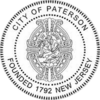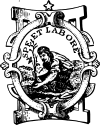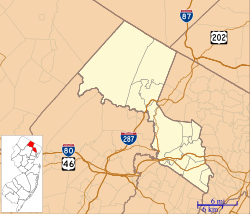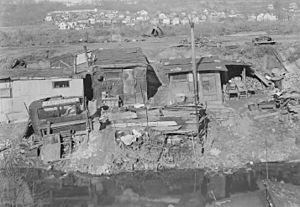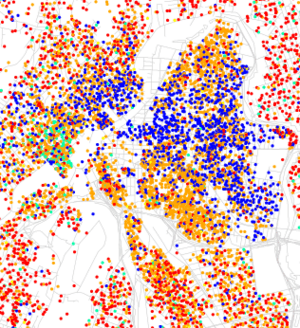Paterson, New Jersey facts for kids
Quick facts for kids
Paterson, New Jersey
|
|||||
|---|---|---|---|---|---|
|
City
|
|||||
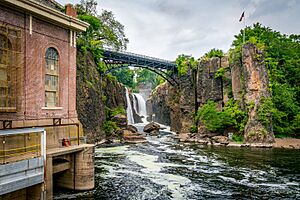
Great Falls of the Passaic River in Paterson in July 2016
|
|||||
|
|||||
| Nickname(s):
The Silk City
|
|||||
| Motto(s):
Spe et Labore (Latin)
"By hope and effort" |
|||||
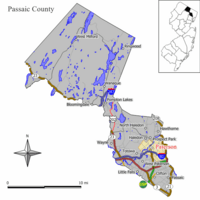
Location of Paterson in Passaic County highlighted in yellow (left). Inset map: Location of Passaic County in New Jersey highlighted in black (right).
|
|||||
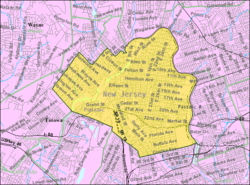
Census Bureau map of Paterson, New Jersey
|
|||||
| Country | |||||
| State | |||||
| County | Passaic | ||||
| Established | November 22, 1791 | ||||
| Incorporated | April 11, 1831 (as township) | ||||
| Reincorporated | April 14, 1851 (as city) | ||||
| Named for | William Paterson | ||||
| Government | |||||
| • Type | Faulkner Act Mayor-Council | ||||
| • Body | City Council | ||||
| Area | |||||
| • Total | 8.71 sq mi (22.55 km2) | ||||
| • Land | 8.41 sq mi (21.79 km2) | ||||
| • Water | 0.29 sq mi (0.76 km2) 3.38% | ||||
| Area rank | 224th of 565 in state 7th of 16 in county |
||||
| Elevation | 112 ft (34.1376 m) | ||||
| Population
(2020)
|
|||||
| • Total | 159,732 | ||||
| • Estimate
(2023)
|
156,452 | ||||
| • Rank | 168th in country (as of 2023) 3rd of 565 in state 1st of 16 in county |
||||
| • Density | 18,986.3/sq mi (7,330.7/km2) | ||||
| • Density rank | 11th of 565 in state 2nd of 16 in county |
||||
| Time zone | UTC−05:00 (Eastern (EST)) | ||||
| • Summer (DST) | UTC−04:00 (Eastern (EDT)) | ||||
| ZIP Codes |
07501-07505, 07508–07514, 07522, 07524, 07533, 07538, 07543, 07544
|
||||
| Area code(s) | 201 and 973 | ||||
| FIPS code | 3403157000 | ||||
| GNIS feature ID | 0885343 | ||||
Paterson is the largest city in Passaic County, New Jersey. It is also the county seat. In 2020, Paterson was the third-most-populous city in New Jersey. It had a population of 159,732 people.
Paterson is famous for its history as a "mill town." It was once known as Silk City because it produced so much silk. Today, it is a major home for immigrants from many places. These include Hispanic countries, Turkey, the Arab world, and South Asia. Paterson has one of the largest Muslim populations per person in the United States.
Contents
- History of Paterson
- Geography of Paterson
- Paterson's Climate
- Paterson's Population
- Economy of Paterson
- Arts and Culture in Paterson
- Athletics in Paterson
- Media in Paterson
- Emergency Services in Paterson
- Transportation in Paterson
- Education in Paterson
- Sister Cities
- Notable People from Paterson
- Images for kids
- See also
History of Paterson
Paterson's area was first home to the Lenape Native Americans. They were also called the Delaware Indians. Later, the Dutch claimed the land, followed by the British.
How Paterson Was Founded
In 1791, Alexander Hamilton helped start a group called the Society for Establishing Useful Manufactures (S.U.M.). This group wanted to use the power of the Great Falls of the Passaic River. Their goal was to make America more independent from British factories. Paterson was founded by this society. It became a very important place for the Industrial Revolution in America.
The city was named after William Paterson. He was a statesman and a governor of New Jersey. He signed the document that created the town in 1792.
Pierre Charles L'Enfant, who designed Washington, D.C., was the first planner for Paterson. He wanted to use a special channel to power the factories. But the society thought his plans were too slow and costly. Another engineer, Peter Colt, took over. His system worked for a while, but later, L'Enfant's original idea was used.
Paterson officially became a township in 1831. It became a city in 1851.
Paterson's Industrial Growth
The 77-foot-high Great Falls powered Paterson's industries. A system of water channels, called raceways, sent water to the mills. This helped the city grow. Factories made textiles, firearms, silk, and even train engines.
In the late 1800s, silk production became the biggest industry. This made Paterson known as "Silk City." In 1835, Samuel Colt started making firearms here. Later, John Philip Holland experimented with submarines in Paterson. You can see two of his early submarines at the Paterson Museum.
Many immigrants came to Paterson to work in the factories. They worked long hours for low pay. In 1913, there was a big silk strike. Workers wanted an eight-hour day and better conditions. They lost the strike, and factories later moved to other places.
Athletics in Paterson
In 1932, Paterson opened Hinchliffe Stadium. This stadium could hold 10,000 people. It was named after Mayor John V. Hinchliffe. It hosted high school and professional sports.
From 1933 to 1945, the New York Black Yankees played baseball here. They were part of the Negro National League. The stadium also hosted football games, track events, boxing, and auto races. Famous comedians Bud Abbott and Lou Costello performed there. Costello was from Paterson.
Hinchliffe Stadium is one of only two Negro League stadiums still standing. It is a historic landmark.
Paterson After World War II
During World War II, Paterson was important for making aircraft engines. After the war, many cities faced challenges. Paterson saw a decline in jobs and people moving away.
Once, downtown Paterson was a popular shopping area. But new malls in nearby towns caused many big stores to leave. Now, small businesses are the main part of the city's economy. Immigrants continue to move to Paterson, helping to revive the city's economy.
The downtown area has had several large fires. One big fire in 1991 destroyed a whole city block. Many historic buildings were lost. The area was rebuilt with an outdoor mall.
Paterson has many places listed on the National Register of Historic Places. These include City Hall, Hinchliffe Stadium, and the Great Falls Historic District.
In 2011, Hurricane Irene caused major flooding in Paterson. The Passaic River rose to very high levels. Thousands of people had to leave their homes.
Geography of Paterson
Paterson covers about 8.7 square miles. Most of this is land, with a small amount of water.
Paterson shares borders with several towns. These include Clifton, Haledon, and Hawthorne.
Paterson's Neighborhoods


- The Great Falls Historic District is famous for the Great Falls of the Passaic River. The city is working to improve this area. Old factory buildings are being turned into apartments and shops. The Paterson Museum is also in this district.
- Downtown Paterson is the main shopping area. After a big fire in 1902, the downtown was rebuilt. Many beautiful buildings from that time are still there. Paterson City Hall is in Downtown Paterson. It looks like a city hall in Lyon, France, which was also a silk capital.
- Eastside Park Historic District has about 1,000 homes in different styles. These include Tudors and Victorians. This area was once home to the city's rich leaders. Many historic houses are being restored. Eastside Park is the highlight of this neighborhood.
- South Paterson is a very diverse neighborhood. It has many immigrants from the Middle East. It is sometimes called Little Istanbul or Little Ramallah. You can find many shops and restaurants that serve this community. Signs are often in Arabic.
- Lakeview is in the southern part of the city. It is a middle-class neighborhood. It is home to the Paterson Farmers Market. Many people come here to buy fresh food. This neighborhood is mostly Hispanic. It also has people from Europe, the Middle East, Africa, and Asia.
- Hillcrest is a quiet, mostly residential neighborhood. It is west of downtown. It is one of Paterson's most popular neighborhoods.
- People's Park is known for 21st Avenue, or "La Ventiuno." This street has many shops and services for the diverse community. It used to have a large Italian population. Now, it has many first-generation Hispanic people, especially from Colombia.
- Wrigley Park is a neighborhood that has faced challenges. But new houses are being built, and crime has gone down.
- Sandy Hill is home to a growing Hispanic community, mostly from the Dominican Republic. Roberto Clemente Park is in this neighborhood.
- Northside is north of Downtown. It has hills and great views of the New York City skyline.
- Totowa section is a large neighborhood west of the Passaic River. It has a big Hispanic community and a growing South Asian community, mainly from Bangladesh. Many Bengali stores are on Union Avenue.
- Stoney Road is Paterson's southwest neighborhood. It has Pennington Park and the Lou Costello Pool. Many Italian families still live here.
- Riverside is a working-class neighborhood. It is next to the Passaic River. It is very diverse, with a growing Hispanic community. Many Albanians also live here.
Paterson's Climate
Paterson has hot, humid summers. The winters are generally cool to cold.
Paterson's Population
| Historical population | |||
|---|---|---|---|
| Census | Pop. | %± | |
| 1840 | 7,596 | — | |
| 1850 | 11,334 | 49.2% | |
| 1860 | 19,586 | 72.8% | |
| 1870 | 33,579 | 71.4% | |
| 1880 | 51,031 | 52.0% | |
| 1890 | 78,347 | 53.5% | |
| 1900 | 105,171 | 34.2% | |
| 1910 | 125,600 | 19.4% | |
| 1920 | 135,875 | 8.2% | |
| 1930 | 138,513 | 1.9% | |
| 1940 | 139,656 | 0.8% | |
| 1950 | 139,336 | −0.2% | |
| 1960 | 143,663 | 3.1% | |
| 1970 | 144,824 | 0.8% | |
| 1980 | 137,970 | −4.7% | |
| 1990 | 140,891 | 2.1% | |
| 2000 | 149,222 | 5.9% | |
| 2010 | 146,199 | −2.0% | |
| 2020 | 159,732 | 9.3% | |
| 2023 (est.) | 156,452 | 7.0% | |
| Population sources: 1800–1920 1840–1900 1840–1870 1840 1850 1870 1880–1890 1890–1910 1860–1930 1940–2000 2000 2010 2020 |
|||
Paterson is known for its many different ethnic groups. In 2014, the mayor said there were 52 different groups. By 2020, Paterson had the second-largest Muslim population in the U.S. by percentage.
Paterson has large communities of people from Bangladesh, Turkey, Arab countries, Albania, Bosnia, the Dominican Republic, and Peru. The Peruvian community is one of the biggest outside South America.
Who Lives in Paterson?
Many different groups have settled in Paterson over time. In the 1800s, Irish, Germans, Dutch, and Jewish people came. Later, Italian and Eastern European immigrants arrived. Since 1890, Syrian, Lebanese, and Palestinian immigrants have also come.
African Americans from the South moved to Paterson in the 1900s. The city also has people of African descent who have lived there for a long time. A house in Paterson was even a stop on the Underground Railroad. This was a secret network that helped enslaved people escape to freedom.
Since the 1950s, many Puerto Ricans have made Paterson their home. Today, many Hispanic immigrants are from the Dominican Republic, Peru, Colombia, Mexico, and Central America. The Dominican community is the largest Hispanic group in the city.
Western Market Street is sometimes called Little Lima. It has many Peruvian and other Latin American businesses. East Market Street has many Dominican-owned shops. Main Street, south of downtown, has a large Mexican community.
Main Street, near the Clifton border, has many Turkish and Arab businesses. 21st Avenue is known for its Colombian and other Latin American restaurants.
Every summer, Paterson celebrates its diverse cultures. There are parades for African-American Day, Dominican Day, Puerto Rican Day, Peruvian Day, and Turkish-American Day.
Paterson is seen as the capital of the Peruvian community in the U.S. Little Lima is a Peruvian area in Downtown Paterson. It is home to about 10,000 Peruvian immigrants. Paterson has even named an area "Peru Square."
Paterson also has the third-largest Dominican-American community in the U.S. A part of Park Avenue is called "Dominican Republic Way."
The city is home to the largest Turkish-American community in the U.S., known as Little Istanbul. It also has the second-largest Arab-American community after Dearborn, Michigan. This area is sometimes called Little Ramallah.
Paterson has a fast-growing Bangladeshi-American community. It is the largest outside New York City.
Economy of Paterson
Paterson is part of an Urban Enterprise Zone (UEZ). This program helps encourage businesses and jobs in the city. Shoppers in these zones can pay a lower sales tax. Paterson's UEZ status helps its economy grow.
Arts and Culture in Paterson
The Paterson Literary Review is published every year. It features poetry, prose, and reviews. Paterson also hosts an annual Poetry Festival. It includes performances, workshops, and contests.
Paterson has many parks. These include Eastside, Westside, and Pennington Parks. The Great Falls of the Passaic are part of the national park system.
The Paterson Museum is in the Great Falls Historic District. It was founded in 1925. It shows the city's industrial history. The museum is in the Thomas Rogers Building. This building used to be a factory that made train engines.
Lambert Castle, also called Belle Vista, was built in 1892. It was the home of Catholina Lambert, a rich silk mill owner. After he died, the building became a museum. It is now the Passaic County Historical Society museum and library.
Near Lambert Castle is a 75-foot observation tower. It is on top of Garret Mountain. From the tower, you can see the New York City skyline.
Athletics in Paterson
Paterson built Hinchliffe Stadium in the 1930s. It is an Art Deco stadium. It was home to the New York Black Yankees baseball team. They played in the Negro National League. The stadium also hosted football, boxing, and music events. Famous comedians Bud Abbott and Lou Costello performed there.
Hinchliffe Stadium is one of only two Negro League baseball stadiums left. It is listed on the National Register of Historic Places. As of 2022, it is home to the New Jersey Jackals minor league baseball team.
Media in Paterson
Paterson has its own radio stations, like WPAT (AM) 930. It is also the home city for WXTV-DT, channel 41. This is the main Spanish-language Univision network station for the New York City area.
Emergency Services in Paterson
The Paterson Police Department keeps the city safe. The Paterson Fire Department has seven fire stations. They also handle emergency medical services and ambulances. The fire department is part of a special team that helps with major rescue situations.
The Passaic County Sheriff's Office also has divisions in Paterson. These include the courts and the county jail.
In 2023, the New Jersey Attorney General took over control of the Paterson Police Department. This happened after a police shooting.
St. Joseph's Regional Medical Center provides emergency and regular medical care for Paterson.
Transportation in Paterson
Roads and Highways
Paterson has many roads and highways. Interstate 80 goes directly through the city. Other state routes like 4, 19, and 20 also serve Paterson. Major roads like the Garden State Parkway are nearby.
Historically, Paterson was a starting point for important roads. The Paterson Plank Road connected it to Jersey City. The Paterson-Hamburg Turnpike went to Sussex County.
Public Transportation
NJ Transit provides commuter rail service to Hoboken. The train station is in Downtown Paterson. There are also plans for new train service on the existing NYS&W line.
Buses connect Paterson to other counties like Bergen and Essex. The Broadway Bus Terminal in downtown Paterson is a major bus hub. Buses go to Midtown Manhattan and Newark.
Private jitney buses, also called dollar vans, also connect Paterson to nearby towns. They offer frequent rides to Manhattan.
Education in Paterson
The Paterson Public Schools serve students from pre-kindergarten to twelfth grade. The district has 51 schools. In 2018–19, there were over 27,600 students.
In 2011, all of Paterson's high schools became "theme schools." This means students can choose schools that focus on specific areas of interest.
Paterson has several charter schools. These include Paterson Charter School for Science and Technology.
The city hosts an annual robotics competition at Passaic County Community College. Schools from all over New Jersey compete.
Passaic County Community College has its main campus in Paterson. It serves thousands of students.
Sister Cities
Paterson has "sister city" relationships with cities around the world. These partnerships help build friendships and understanding.
Friendship with Montescaglioso
Paterson also has a special friendship with Montescaglioso, Italy. Many people from Montescaglioso moved to Paterson over the years. Both cities have streets named after each other.
- "Avenue Paterson" in Montescaglioso
- "Montescaglioso Street" in Paterson
Notable People from Paterson
Many famous people have come from Paterson or lived there. Here are a few:
- Lou Costello (1906–1959), a famous comedian and actor, part of the duo Abbott and Costello. (Born in Paterson)
- Victor Cruz (born 1986), a wide receiver who won the Super Bowl with the New York Giants.
- Larry Doby (1923–2003), a Baseball Hall of Fame player. He was the second African American to play in Major League Baseball.
- Allen Ginsberg (1926–1997), a very important poet of the 20th century.
- Garret A. Hobart (1844–1899), who served as the 24th Vice President of the United States.
- J. Michael Straczynski (born 1954), a science-fiction writer who created the show Babylon 5. (Born in Paterson)
- William Carlos Williams (1883–1963), a famous modern poet who wrote a long poem called "Paterson" about the city.
Images for kids
-
Interstate 80 westbound in Paterson
See also
 In Spanish: Paterson (Nueva Jersey) para niños
In Spanish: Paterson (Nueva Jersey) para niños


